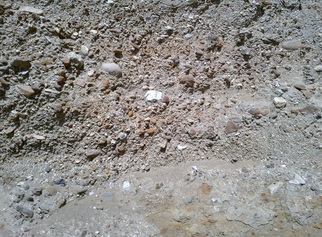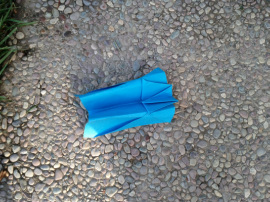 Backdrop of Sedimentary rock formation
Backdrop of Sedimentary rock formation It was Mother's Day and we were at Half Moon Bay. We were just wrapping up a great day by the Ocean, when I noticed this awesome Sedimentary rock formation. Of course, I could not pass up the opportunity to impart a little scientific knowledge!
I started to explain that when mountains are first formed, they are tall and jagged like the Rocky Mountains on the west coast of North America. Over time (millions of years) mountains become old mountains like the Appalachian Mountains on the east coast of Canada and the United States.
Old mountains are rounded and lower. The rocks erode or get eaten away by natural elements like rain, wind, freeze/thaw cycle and stream or rivers flowing down cause the big mountains to crumble slowly.
These crumbled or battered rock pieces or "sediments," land in the streams and rivers that flow down from the mountains. They settle down on the bottom of the lake or oceans they run into. Over time, layers of different rocks settle at the bottom of lakes and oceans. This sediment compresses over a long period of time and consolidates into solid layers of rock. These layers are called strata.
Some examples of sedimentary rocks are sandstone and shale. The pictures below are sandstone formation. Though it is hard to tell in the picture above, this formation was actually reddish in color and sandy; some of the stones actually broke apart easily. Notice the second slide; the layer of rock underneath is a different color (black spots) than the rock layer on top.
There are 6 main kinds of sedimentary rocks. Sedimentary rocks take years and years to form, but you can make your own in days! Click the link below to make your own Sandstone. What are Sedimentary rocks?
Cool Facts!
Sedimentary rocks cover 75% of the earth’s surface. Most of the rocks found on the Earth’s surface is sedimentary even though sedimentary rocks only make up less than 5% of all the rocks that make up Earth.
I started to explain that when mountains are first formed, they are tall and jagged like the Rocky Mountains on the west coast of North America. Over time (millions of years) mountains become old mountains like the Appalachian Mountains on the east coast of Canada and the United States.
Old mountains are rounded and lower. The rocks erode or get eaten away by natural elements like rain, wind, freeze/thaw cycle and stream or rivers flowing down cause the big mountains to crumble slowly.
These crumbled or battered rock pieces or "sediments," land in the streams and rivers that flow down from the mountains. They settle down on the bottom of the lake or oceans they run into. Over time, layers of different rocks settle at the bottom of lakes and oceans. This sediment compresses over a long period of time and consolidates into solid layers of rock. These layers are called strata.
Some examples of sedimentary rocks are sandstone and shale. The pictures below are sandstone formation. Though it is hard to tell in the picture above, this formation was actually reddish in color and sandy; some of the stones actually broke apart easily. Notice the second slide; the layer of rock underneath is a different color (black spots) than the rock layer on top.
There are 6 main kinds of sedimentary rocks. Sedimentary rocks take years and years to form, but you can make your own in days! Click the link below to make your own Sandstone. What are Sedimentary rocks?
Cool Facts!
Sedimentary rocks cover 75% of the earth’s surface. Most of the rocks found on the Earth’s surface is sedimentary even though sedimentary rocks only make up less than 5% of all the rocks that make up Earth.


 RSS Feed
RSS Feed